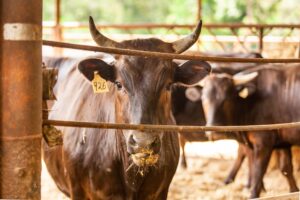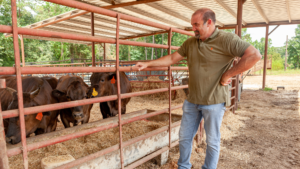Wagyu cattle are known for their high-quality meat and are highly sought after by consumers worldwide. As a Wagyu farmer or rancher, it is essential to maintain the health and performance of your herd to ensure that you can meet the demands of your customers. One effective way to achieve this is by using analytics to monitor your Wagyu herd’s health and performance.
In this blog post, we will discuss the importance of analytics in modern farming, how it can be applied to Wagyu health monitoring, and the benefits it can bring to your herd’s health and productivity. By leveraging the power of analytics, you can gain valuable insights into your herd’s behavior, detect potential issues early, and optimize your farming practices for maximum efficiency and profitability.
DEFINITION OF ANALYTICS
Analytics collects, analyzes, and interprets data to gain insights and make informed decisions. It is a powerful tool for identifying patterns and trends and understanding complex relationships between different variables. Analytics can improve efficiency, reduce costs, and drive growth in many industries, including agriculture.
BENEFITS OF ANALYTICS IN WAGYU CATTLE FARMING
Analytics is an essential tool for the Wagyu cattle farming industry. It helps farmers make informed decisions based on data-driven insights. Here are some of the benefits of analytics in Wagyu cattle farming:
Improved breeding practices: By using data analytics, farmers can analyze the genetic makeup of their Wagyu cattle and identify the best breeding pairs. This helps improve the overall genetic quality of the herd and can result in better meat quality and higher profits.
Efficient resource management: Analytics can help farmers track resource usage, such as feed and water, and identify areas where they can reduce waste and increase efficiency. This can lead to cost savings and improved sustainability.
Disease prevention and management: Analytics can help farmers monitor their Wagyu cattle for signs of disease and identify any potential outbreaks before they become widespread. This can help prevent the spread of disease and minimize losses.
Better meat quality: Analytics can help farmers track various factors that affect meat quality, such as diet, exercise, and breeding practices. By optimizing these factors, farmers can produce Wagyu beef with better marbling, tenderness, and flavor, which can command higher prices in the market.
Enhanced financial performance: Analytics can help farmers track their financial performance and identify areas to improve profitability. For example, by analyzing the cost of production, farmers can identify ways to reduce expenses and increase margins.
TYPES OF ANALYTICS
Some analytics can be used in agriculture. These include:
Descriptive analytics: This analytics involves analyzing historical data to gain insights into past performance. For example, farmers can use descriptive analytics to understand how weather patterns have affected crop yields.
Predictive analytics: It involves using statistical models and machine learning algorithms to predict future events. For example, farmers can use predictive analytics to forecast crop yields based on weather patterns and other variables.
Prescriptive analytics: This type of analytics involves using data to make recommendations about how to improve performance. For example, farmers can use prescriptive analytics to optimize irrigation systems or adjust fertilizer application rates based on soil quality.
Real-time analytics: This type involves analyzing data in real time to gain insights into current performance. For example, farmers can use real-time analytics to monitor crop growth and adjust irrigation systems.
KEY METRICS TO MONITOR IN WAGYU HERDS
Reproductive Performance
Reproductive performance is a critical aspect of any livestock farming operation, and it is no different for Wagyu herds. The breed is highly valued for its wagyu beef quality, and it is crucial to maintain the herd’s productivity levels to ensure a steady supply of premium quality beef.
Calving Rate
One of the key metrics to monitor in Wagyu herds is the calving rate. This refers to the number of live calves born per 100 cows. A high calving rate indicates good reproductive health in the herd, and it is important to maintain a rate of at least 90% or above. Any lower than this could indicate poor fertility, disease, or nutrition.
Weaning Rate
Another critical metric to monitor is the weaning rate: the number of calves weaned per 100 cows. This metric is an important measure of the herd’s productivity and the breeding program’s success. A weaning rate of 85% or above indicates that the calves are healthy, growing well, and surviving the weaning process.
Fertility Rate
To maintain optimal reproductive performance in American Wagyu herds, it is essential to ensure adequate nutrition, monitor herd health, and implement effective breeding management practices. This includes regular monitoring of the cow’s body condition score, regular health checks, and high-quality genetics in breeding programs.
Growth Performance
Wagyu cattle are known for their slow growth rate and high marbling ability, which makes monitoring their growth performance essential to ensure their premium quality wagyu steaks production. The following are the key metrics to monitor for growth performance in American Wagyu cattle.
Weight Gain
Weight gain is the primary indicator of growth performance in Wagyu cattle. Monitoring weight gain allows farmers to assess the effectiveness of their feeding programs and make adjustments as needed. Slow and steady weight gain is typical in Japanese Wagyu beef, and an average daily weight gain of 0.8 to 1.2 kg is considered decent.
Feed Conversion Rate
Feed conversion rate is another essential metric to monitor in American Wagyu beef. It refers to the feed required to produce one kilogram of weight gain in cattle. A low feed conversion rate indicates that the cattle efficiently convert feed into weight gain. An efficient feed conversion rate is desirable in any cattle operation, as it reduces feed costs and maximizes profits.
Average Daily Gain
Average daily gain is the rate at which the animal gains weight daily. It is an important metric to monitor in Wagyu cattle, providing insight into the animal’s overall growth rate. Again, we need to aim for an average daily gain of 0.8 to 1.2 kg for Wagyu cattle.
Health Indicators
Maintaining the health of the Wagyu herd is crucial to ensure their productivity, performance, and quality of meat. The following are the key metrics to monitor for health benefits indicators in Wagyu herds.
Mortality Rate
The mortality rate is the number of deaths per 100 head of cattle in a given period. Monitoring the mortality rate allows farmers to identify and address any health benefit issues or management problems in the herd. A low mortality rate is desirable in any cattle operation, and farmers should aim to keep it below 1%.
Disease Incidence Rate
The disease incidence rate is the number of cases of a specific disease per 100 head of cattle in a given period. Monitoring the disease incidence rate allows farmers to identify potential disease outbreaks and take appropriate measures to prevent their spread. Regular vaccination and biosecurity measures can help reduce the disease incidence rate in the herd.
Vaccination Compliance
Vaccination compliance refers to the percentage of herd cattle receiving the required vaccinations. Regular vaccinations are essential in preventing diseases, and monitoring vaccination compliance ensures that all animals receive the necessary protection. Maintaining high vaccination compliance is critical to the overall health and productivity of the Wagyu breed.
COLLECTING AND ANALYZING DATA FOR HEALTH MONITORING
DATA COLLECTION METHODS
Accurate and timely data collection is essential to monitor Wagyu meat’s health effectively. The following are the key methods for collecting data:
Manual Record-Keeping
Manual record-keeping involves recording data on paper or electronic spreadsheets. This method is cost-effective and simple, making it a popular choice for small-scale Wagyu farming operations. However, it is prone to errors and can be time-consuming to analyze.
Electronic Monitoring Systems
Electronic monitoring systems use sensors and data loggers to collect data on various parameters, such as body temperature, heart rate, and feed intake. This method is more accurate and efficient than manual record-keeping, providing real-time data that can be analyzed quickly.
Wearable Sensors
Wearable sensors are attached to the animal and can monitor various parameters, such as activity levels, rumination, and body temperature. This method is non-invasive and continuously monitors the animal’s health status.
ANALYZING DATA FOR INSIGHTS
Once the data is collected, it must be analyzed to identify trends or patterns indicating health issues. The following are the key methods for analyzing data:
Statistical Analysis
Statistical analysis involves using various statistical methods to identify correlations and trends in the data. This method can help identify risk factors for diseases and provide insights into the overall health status of the herd.
Machine Learning Algorithms
Machine learning algorithms use computer algorithms to analyze data and identify patterns that may not be immediately apparent. This method can help identify complex relationships in the data, leading to more accurate predictions of health issues.
Dashboard Reporting
Dashboard reporting involves presenting the data in an easily understandable format, such as graphs or charts. This method allows farmers to quickly identify trends or patterns requiring attention and make informed decisions about herd health management.
In summary, collecting and analyzing data is critical to monitoring the health of Wagyu herds. Utilizing different data collection methods and analysis techniques can provide valuable insights into the overall health status of the herd and help farmers make informed decisions about herd health management.
Using Analytics to Improve Health and Performance in Wagyu Herds
Identifying Patterns and Trends
Analyzing data can help identify patterns and trends that are not immediately apparent, leading to insights that improve herd health and performance. The following are the key patterns and trends to look out for:
Early Warning Signs of Disease Outbreaks
Monitoring data on disease incidence rates and mortality rates can help identify early warning signs of disease outbreaks. Identifying these patterns can allow farmers to implement preventative measures and reduce the risk of further spread.
Correlations Between Environmental Factors and Performance
Monitoring data on environmental factors such as temperature, humidity, and rainfall can help identify correlations with performance indicators such as weight gain and feed conversion rate. This insight can lead to adjustments in management practices, such as adjusting feeding regimes or providing shelter during extreme weather conditions.
Genetic Markers for Desirable Traits
Analyzing data on genetic markers for desirable traits, such as marbling, can help identify animals with high potential for superior red meat quality. This insight can lead to more targeted breeding practices and the selection of superior breeding stock.
Making Data-Driven Decisions
Analyzing data can help farmers make informed decisions about herd health and management practices. The following are the key areas where data can inform decision-making:
Adjusting Feeding Regimes
Farmers can use data analysis of feed conversion rate and weight gain to optimize their feeding regimes and reduce wastage. By analyzing this data, they can make informed decisions that improve their herd’s performance and reduce costs.
Changing Breeding Practices
Analyzing genetic markers for desirable traits can help farmers select superior breeding stock and make informed decisions about breeding practices. This data analysis enables farmers to produce Wagyu cattle with better meat quality, higher yield, and other desirable traits.
Implementing Preventative Measures
Analyzing data on disease incidence rates and mortality rates can help farmers implement preventative measures, such as vaccination programs, biosecurity protocols, and herd health management plans.
Monitoring Progress and Evaluating Outcomes
Continuous monitoring and evaluation are critical to ensure herd health and performance improvements. The following are the key areas where progress should be monitored:
Setting Performance Targets
Setting performance targets for key indicators, such as weight gain and disease incidence rates, can help farmers track progress over time and identify areas for calories improvement.
Measuring Success
Regularly measuring key performance indicators and comparing them to performance targets can help farmers evaluate the success of management practices and adjust accordingly.
Continuously Improving Herd Health and Performance
Analyzing data and making data-driven decisions can lead to continuous improvement in herd health and performance over time. Regular monitoring and evaluation of progress are critical to ensure ongoing success.
Using analytics to improve health and performance in Wagyu herds is critical to ensuring the long-term success of farming operations. Identifying patterns and trends, making data-driven decisions, and continuously monitoring progress and evaluating outcomes can improve herd health and superior meat quality.
EXAMPLE OF A WAGYU FARM USING ANALYTICS
Reproductive performance is a critical aspect of any livestock farming operation, and it is no different for Wagyu herds. The breed is highly valued for its wagyu beef quality, and it is crucial to maintain the herd’s productivity levels to ensure a steady supply of premium quality beef.
Real-World Results of Health and Performance Monitoring
Blackmore Wagyu has seen significant results from using analytics for health and performance monitoring. By analyzing data on weight gain and feed conversion rate, the farm was able to optimize feeding regimes and reduce waste, resulting in a 20% reduction in feed costs. Additionally, by monitoring animal health indicators and implementing preventative measures, the farm was able to reduce disease incidence rates and mortality rates, improving overall animal health. These practices have also improved meat quality, with Blackmore Wagyu winning numerous awards for their superior beef.
frequently asked questions
Many types of data can be used to monitor health and performance in a Wagyu herd, such as breeding and calving records, weight and growth rate data, feed intake and conversion rates, and health monitoring data (such as temperature, heart rate, and respiratory rate). Genetics and pedigree information can also be incorporated to identify superior traits and select for breeding.
Using analytics in a Wagyu herd can help farmers identify trends and patterns in their data, which can provide insights into the health and performance of individual animals and the herd as a whole. This information can help farmers make data-driven decisions about breeding, feeding, and healthcare practices to improve the overall health and productivity of the herd.
Many tools and software options are available for analyzing data in a Wagyu herd. These include spreadsheet software such as Microsoft Excel or Google Sheets and more specialized software such as livestock management systems like HerdMaster or CattleMax. Additionally, some farmers may work with data analysts or consultants specializing in livestock analytics.
tent
Data should ideally be collected and analyzed regularly, such as weekly or monthly, to identify trends and patterns in the data. However, the frequency of data collection and analysis may vary depending on the size of the herd, the available data collection resources, and the farmer’s specific goals and needs.
One common challenge with using analytics in a Wagyu herd is ensuring the collected data is accurate and consistent. This may require implementing standard procedures for data collection and training staff to collect data consistently.
Final Thoughts On Wagyu Health Monitoring
By implementing analytics in Wagyu farming, farmers can detect health issues early, minimize disease outbreaks, and improve animal welfare. It can also help farmers track performance indicators such as weight gain and feed conversion, which are crucial for efficient farming practices.
Moreover, using analytics can provide a competitive advantage for farmers in the Wagyu market. Farmers can increase profitability and maintain a competitive edge in the market by improving the quality of meat produced and optimizing production costs.
In conclusion, applying analytics to monitor health and performance in Wagyu farming is a powerful tool that can provide farmers with the insights they need to improve their farming practices, increase productivity, and maximize profitability. With the increasing demand for high-quality meat, farmers who embrace analytics in their farming practices will have a significant advantage in the market, and their Wagyu herds will thrive.


